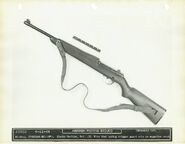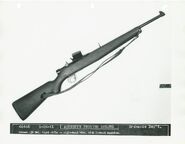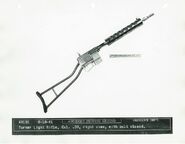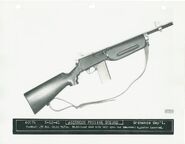The US light rifle trials were a series of tests conducted in 1940 and 1941.
Procedure[]
The tests were carried out over a series of light rifles; these would eventually lead to the development of the M1 Carbine. The campaign started in October 1940, where 9 designs were entered. Tests were carried out 4 months later on February 1, 1941.
Contenders[]
This is a carbine submitted by the Auto-Ordnance company, along with the Thompson Auto Rifle. It was one of the seven designs that was not rejected.
While technically not submitted during the trials as the M1 had been in service for some time already, Howard Clarke decided to submit it anyway. It performed okay, but was said to not be practical for military use until its flaws were corrected.
A carbine manufactured by John Garand. It had an unusual magazine placement; mounted on the top of the receiver, with the well tilted 30 degrees to the right. While odd, it performed well in trials. A second version was also submitted with a more conventional layout.
Submitted by Harrington & Richardson, this weapon was a copy of their Reising M50 with a 5 round magazine. It performed okay, but functionality was not the best due to ruptured cases.
- Possibly the Hillberg carbine
A blow-forward .30 carbine rifle designed by Robert J. Hillberg. It held 20 rounds in a box magazine.
- High-Standard carbine
The rifle was submitted to the trials by the High Standard manufacturing corporation, but required a new chamber and the rifle was sent back to the factory for the procedure. However, it was never resubmitted, and was never tested or fired by the testers.
One of the better contenders, the rifle was submitted by George Hyde of the Bendix Aviation Corporation. It went through most of the tests well, and the committee recommended it be modified a bit with a stronger recoil spring. A second version was made, but it was deemed inferior to the first.
A carbine with a barrel change mechanism similar to that of an MG 42, the rifle performed reasonably well when compared to other designs.
The Savage carbine was submitted by John Pierce of the Savage Arms company. Testing of the rifle went very smoothly until the breech bolt housing of the rifle broke at round number 2882. Up until that point, the rifle was said to be one of the best contenders, with excellent accuracy and handling. In spite of this, testers noted the rifle for being very complex when compared to all the other light rifles.
- Simpson carbine
This rifle was submitted to the trials by the Springfield Corporation, but was immediately eliminated for being too heavy.
This was a light rifle submitted by Auto-Ordnance Corporation of Thompson submachine gun fame. Interestingly enough, the Thompson design was more accurate than the M1 Carbine adopted, and came with select fire.
This was a very unusual carbine design, submitted by a private inventor from Pennsylvania, Russell Turner. It featured an unusual metal forearm and tubular metal stock, and had select fire capabilities; these were enabled by turning the hexnut socket behind the trigger. The Turner did not perform well during tests, despite good accuracy and handling. As such, Turner made a second variant of the rifle, which showed promise, but was deemed to require better execution.
Submitted by the Woodhull Corporation from New Jersey, it was basically just a Winchester Model 1905 cut down in size. Despite the design origins, the Woodhull performed poorly and was dropped from the program after the primary tests.












